Ruckus Wireless ZF7761CM User Manual

Ruckus Wireless™
ZoneFlex™ 7761CM Dual Band 802.11n Outdoor Access Point
with Integrated Cable Modem
Installation Guide
Part Number 800-70290-001
Published March 2010
www.ruckuswireless.com

Contents
1 About This Installation Guide . . . . . . . . . . . . . . . . . . . . . . . . . . . . . . . . . . . . . . . . . . . . . . . |
. 1 |
|
|
Related Documentation . . . . . . . . . . . . . . . . . . . . . . . . . . . . . . . . . . . . . . . . . . . . . . . . . . . |
1 |
|
Using ZoneDirector to Manage the CMAP . . . . . . . . . . . . . . . . . . . . . . . . . . . . . . . . . . . . |
1 |
|
Terms Used in This Guide . . . . . . . . . . . . . . . . . . . . . . . . . . . . . . . . . . . . . . . . . . . . . . . . . |
1 |
2 |
Unpacking the CMAP . . . . . . . . . . . . . . . . . . . . . . . . . . . . . . . . . . . . . . . . . . . . . . . . . . . . . . . |
2 |
|
Package Contents . . . . . . . . . . . . . . . . . . . . . . . . . . . . . . . . . . . . . . . . . . . . . . . . . . . . . . . . |
2 |
3 |
Preparing for Installation . . . . . . . . . . . . . . . . . . . . . . . . . . . . . . . . . . . . . . . . . . . . . . . . . . . . |
4 |
|
Preconfiguring the Access Point (Standalone Only) . . . . . . . . . . . . . . . . . . . . . . . . . . . . |
4 |
|
Step 1: Prepare the Administrative Computer . . . . . . . . . . . . . . . . . . . . . . . . . . . . . . . . |
5 |
|
Step 2: Supply Power to the CMAP . . . . . . . . . . . . . . . . . . . . . . . . . . . . . . . . . . . . . . . . |
8 |
|
Step 3: Log Into the Access Point’s Web Interface . . . . . . . . . . . . . . . . . . . . . . . . . . . . |
9 |
|
Step 4: Configure the Wireless Settings . . . . . . . . . . . . . . . . . . . . . . . . . . . . . . . . . . . . |
10 |
|
Step 5: Disconnect the CMAP from the Administrative Computer . . . . . . . . . . . . . . |
14 |
|
Step 6: Restore the Administrative Computer’s Network Settings . . . . . . . . . . . . . . |
14 |
|
Pointing the CMAP to ZoneDirector . . . . . . . . . . . . . . . . . . . . . . . . . . . . . . . . . . . . . . . . |
14 |
|
Use SSH to Set the ZoneDirector IP Address on the CMAP . . . . . . . . . . . . . . . . . . . . |
15 |
|
Configure Option 43 on the DHCP Server (ZoneDirector Management Only) . . . . . |
16 |
4 |
Hardware Features . . . . . . . . . . . . . . . . . . . . . . . . . . . . . . . . . . . . . . . . . . . . . . . . . . . . . . . . |
28 |
|
Weight and Dimensions . . . . . . . . . . . . . . . . . . . . . . . . . . . . . . . . . . . . . . . . . . . . . . . . . . |
30 |
|
Connectors . . . . . . . . . . . . . . . . . . . . . . . . . . . . . . . . . . . . . . . . . . . . . . . . . . . . . . . . . . . . |
31 |
|
Ethernet/PoE-Out Port . . . . . . . . . . . . . . . . . . . . . . . . . . . . . . . . . . . . . . . . . . . . . . . . . . . |
31 |
|
LEDs . . . . . . . . . . . . . . . . . . . . . . . . . . . . . . . . . . . . . . . . . . . . . . . . . . . . . . . . . . . . . . . . . . |
31 |
|
Supported Power Sources . . . . . . . . . . . . . . . . . . . . . . . . . . . . . . . . . . . . . . . . . . . . . . . . |
33 |
|
Heaters . . . . . . . . . . . . . . . . . . . . . . . . . . . . . . . . . . . . . . . . . . . . . . . . . . . . . . . . . . . . . . . . |
33 |
5 |
Before You Begin . . . . . . . . . . . . . . . . . . . . . . . . . . . . . . . . . . . . . . . . . . . . . . . . . . . . . . . . . |
33 |
|
Prepare the Required Hardware and Tools . . . . . . . . . . . . . . . . . . . . . . . . . . . . . . . . . . |
33 |
|
Perform a Site Survey . . . . . . . . . . . . . . . . . . . . . . . . . . . . . . . . . . . . . . . . . . . . . . . . . . . . |
34 |
i

6 Powering the CMAP . . . . . . . . . . . . . . . . . . . . . . . . . . . . . . . . . . . . . . . . . . . . . . . . . . . . . . . 35 Using DC Power (Staging or Debugging Only) . . . . . . . . . . . . . . . . . . . . . . . . . . . . . . . 35 Using Power Over Cable (Actual Deployment) . . . . . . . . . . . . . . . . . . . . . . . . . . . . . . . 35
7 Verifying Access Point Operation . . . . . . . . . . . . . . . . . . . . . . . . . . . . . . . . . . . . . . . . . . . . 36
8 Switching LEDs to Cable Modem Mode. . . . . . . . . . . . . . . . . . . . . . . . . . . . . . . . . . . . . . . 36 Using the AP’s Web Interface to Switch to CM Mode . . . . . . . . . . . . . . . . . . . . . . . . . . 37 Using SNMP to Switch to CM Mode . . . . . . . . . . . . . . . . . . . . . . . . . . . . . . . . . . . . . . . . 38
9 Resetting the Access Point to Factory Default Settings . . . . . . . . . . . . . . . . . . . . . . . . . . |
40 |
Using the Reset Switch on the DC Power Supply . . . . . . . . . . . . . . . . . . . . . . . . . . . . . |
40 |
Using SNMP to Reset the Access Point . . . . . . . . . . . . . . . . . . . . . . . . . . . . . . . . . . . . . |
41 |
Before You Begin . . . . . . . . . . . . . . . . . . . . . . . . . . . . . . . . . . . . . . . . . . . . . . . . . . . . . . |
41 |
10 Resetting the CM to Factory Default Settings . . . . . . . . . . . . . . . . . . . . . . . . . . . . . . . . . . 43 Before You Begin . . . . . . . . . . . . . . . . . . . . . . . . . . . . . . . . . . . . . . . . . . . . . . . . . . . . . . 43
11 Mounting the CMAP. . . . . . . . . . . . . . . . . . . . . . . . . . . . . . . . . . . . . . . . . . . . . . . . . . . . . . . 44
12 Installing the Antennas . . . . . . . . . . . . . . . . . . . . . . . . . . . . . . . . . . . . . . . . . . . . . . . . . . . . . 45
13 What to Do Next . . . . . . . . . . . . . . . . . . . . . . . . . . . . . . . . . . . . . . . . . . . . . . . . . . . . . . . . . . 46 Change the Administrative Password . . . . . . . . . . . . . . . . . . . . . . . . . . . . . . . . . . . . . . . 46 Read Related Documentation . . . . . . . . . . . . . . . . . . . . . . . . . . . . . . . . . . . . . . . . . . . . . 46
14 Troubleshooting . . . . . . . . . . . . . . . . . . . . . . . . . . . . . . . . . . . . . . . . . . . . . . . . . . . . . . . . . . 46
Retrieving the CM’s MAC Address . . . . . . . . . . . . . . . . . . . . . . . . . . . . . . . . . . . . . . . . . 46
How Radio Frequency Scanning Works . . . . . . . . . . . . . . . . . . . . . . . . . . . . . . . . . . . . . 47
Contacting Ruckus Wireless Support . . . . . . . . . . . . . . . . . . . . . . . . . . . . . . . . . . . . . . . 47
ii

1 About This Installation Guide
This Installation Guide provides information on how to set up the Cable Modem Access Point (CMAP) on your network. Topics covered in this guide include installation, basic configuration, operation, and device mounting.
This guide is intended for use by those responsible for installing and setting up network equipment. Consequently, it assumes a basic working knowledge of local area networking, cable modem setup and configuration, wireless networking, and wireless devices.
NOTE: The cable modem and access point each have its own independent firmware load that are updated independently.
Related Documentation
In addition to this guide, each Cable Modem Access Point documentation set includes the following:
■User Guide: Provides detailed information on how to configure the functions of the unit. The User Guide is available for download on the Ruckus Wireless Support Web site at:
http://support.ruckuswireless.com/documents
■Release Notes: Provides late-breaking information about the current software release, including new features, enhancements, and known issues. If the information in the Release Notes differs from the information in this guide, follow the instructions in the Release Notes.
■Online Help: Accessible from the CMAP’s Web interface, the Online Help provides information that helps you configure the device from the Web interface.
Using ZoneDirector to Manage the CMAP
If you are planning to use a Ruckus Wireless ZoneDirector to manage the CMAP, this guide describes the required steps that will enable the access point to report to and communicate with ZoneDirector successfully. Refer to “Configure Option 43 on the DHCP Server (ZoneDirector Management Only)” on page 16.
Terms Used in This Guide
Before continuing, Ruckus Wireless recommends that you become familiar with the following terms:
■Access Point (AP): The Wi-Fi component of the Cable Modem Access Point (CMAP).
1

Unpacking the CMAP
Package Contents
■Cable Modem (or CM): The cable modem component of the Cable Modem Access Point (CMAP).
■Cable Modem Access Point (or ZF7761CM): The whole unit, which includes the CM and AP, as well as the power supply.
2Unpacking the CMAP
1.Open the CMAP package, and then carefully remove the contents.
2.Return all packing materials to the shipping box, and put the box away in a dry location.
3.Verify that all items listed in Package Contents below are included in the package. Check each item for damage. If any item is damaged or missing, notify your authorized Ruckus Wireless sales representative.
Package Contents
A complete ZoneFlex 7761CM package contains all of the items listed below:
■
■
■
■
■
ZoneFlex 7761CM unit
Three N-type 5GHz external antennas
Service Level Agreement / Limited Warranty Statement
Regulatory Statement
This Installation Guide
NOTE: The CMAP comes preinstalled with the cable strand interface, which you will use to mount the assembly onto the cable strand. You only need to attach the three external antennas to the cable strand interface (after mounting the CMAP on the strand) to complete the assembly. See “Installing the Antennas” on page 45 for more information.
2
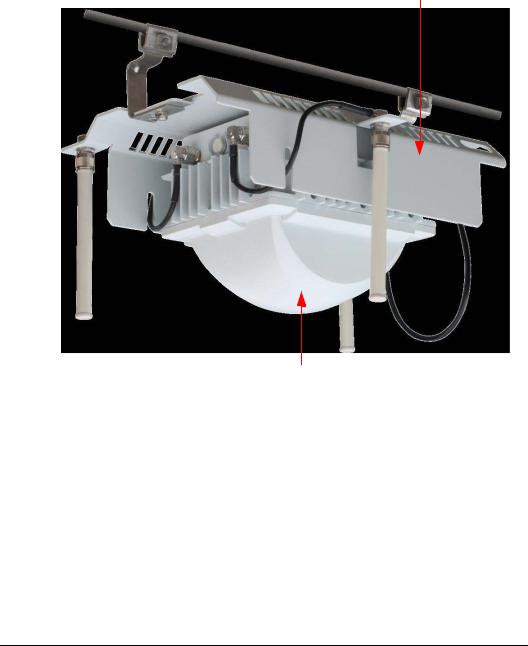
Unpacking the CMAP
Package Contents
Figure 1. The CMAP comes preassembled with the cable strand interface
Cable Strand
Interface
Access Point
3

Preparing for Installation
Preconfiguring the Access Point (Standalone Only)
3 Preparing for Installation
This section describes the tasks that you need to perform before proceeding with the installation. The required tasks depend on whether you are deploying the access point as a standalone device or as a ZoneDirector-managed device.
■Preconfiguring the Access Point (Standalone Only)
■Configure Option 43 on the DHCP Server (ZoneDirector Management Only)
NOTE: A standalone access point refers to a device that is not managed by Ruckus Wireless ZoneDirector or Ruckus Wireless FlexMaster.
Preconfiguring the Access Point (Standalone Only)
If you are deploying the access point as a standalone device, Ruckus Wireless strongly recommends that you preconfigure (or “stage”) the unit before mounting it. It is more convenient to connect the administrative computer to the access point and configure the device in the lab than when the device is already mounted on the cable strand.
Preconfiguring the access point requires the following tasks to be completed:
■
■
■
■
■
■
Step 1: Prepare the Administrative Computer
Step 2: Supply Power to the CMAP
Step 3: Log Into the Access Point’s Web Interface
Step 4: Configure the Wireless Settings
Step 5: Disconnect the CMAP from the Administrative Computer
Step 6: Restore the Administrative Computer’s Network Settings
Before starting, prepare the following requirements:
■DC power supply (see DC Power Supply in “Connectors” on page 31)
■One Ethernet cable
■An administrative computer (any computer running Windows that you will use to preconfigure the access point)
4

Preparing for Installation
Preconfiguring the Access Point (Standalone Only)
Step 1: Prepare the Administrative Computer
NOTE: The following procedures are applicable if the administrative computer is running on Windows XP. If you are using a different operating system, refer to the documentation that was shipped with your operating system for information on how to modify the computer’s IP address settings.
On Microsoft Windows 7
1.Click the  orb, and then click Control Panel.
orb, and then click Control Panel.
2.Double-click Network and Sharing Center.
3.On the left menu, click Change Adapter Settings. The Network Connections page appears and displays the available network interfaces on the computer.
4.Look for the network connection icon labeled Local Area Connection.
5.Right-click Local Area Connection, and then click Properties. The Local Connection Properties dialog box appears.
6.Under This connection uses the following items, look for Internet Protocol Version 4 (TCP/IPv4), and then double-click the item. The Internet Protocol Version 4 (TCP/IPv4) Properties dialog box appears.
7.Write down all of the currently active network settings. You will need this information later when you restore your computer to its current network configuration.
8.On the General tab, Click Use the following IP address, and then configure the IP address settings with the values listed in Table 2. For a sample configuration, refer to Figure 3.
Table 1. Configure your computer’s IP address settings
IP address |
192.168.100.77 (or any address in the |
|
192.168.100.x network — with the exception of |
|
192.168.100.2, which is already used by the access |
|
point) |
|
|
Subnet mask |
255.255.255.0 |
|
|
9.Click OK to save your changes and close the Internet Protocol Version 4 (TCP/IPv4) Properties dialog box.
10.Click OK again to close the Local Area Connection Properties dialog box. Windows saves the IP address settings that you configured.
5
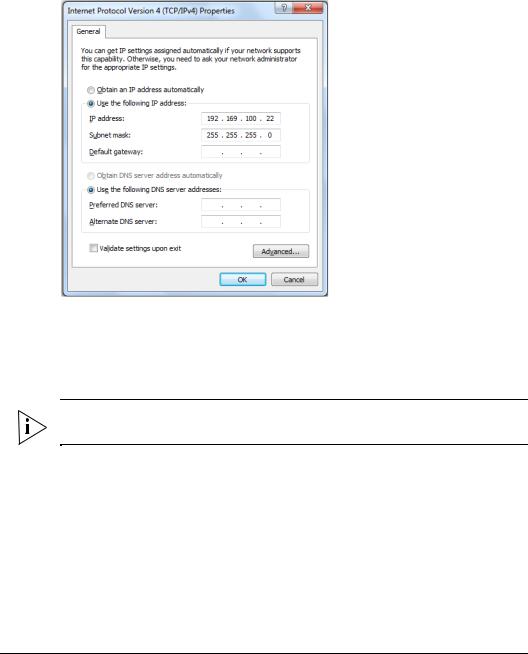
Preparing for Installation
Preconfiguring the Access Point (Standalone Only)
Figure 2. Sample configuration in the Internet Protocol Version 4 (TCP/IPv4) Properties dialog box
On Microsoft Windows XP
1.Click Start > Control Panel > Network Connections.
2.When the Network Connections window appears, right-click the icon for Local Area Connection, and then click Properties.
NOTE: Make sure that you configure the Local Area Connection properties, not the Wireless Network Connection properties.
3.When the Local Area Connection Properties dialog box appears, select Internet Protocol (TCP/IP) from the list, and then click Properties. The Internet Protocol (TCP/ IP) Properties dialog box appears.
4.Write down all of the currently active network settings. You will need this information later when you restore your computer to its current network configuration.
6
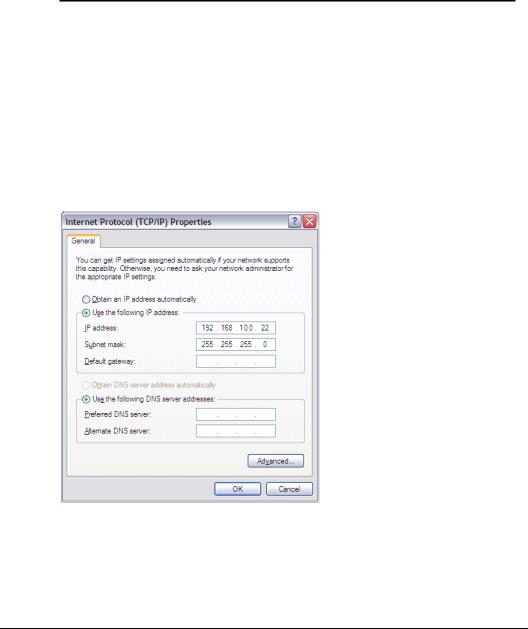
Preparing for Installation
Preconfiguring the Access Point (Standalone Only)
5.Click Use the following IP address, and then configure the IP address settings with the values listed in Table 2. For a sample configuration, refer to Figure 3.
Table 2. Configure your computer’s IP address settings
IP address |
192.168.100.77 (or any address in the |
|
192.168.100.x network — with the exception of |
|
192.168.100.2, which is already used by the access |
|
point) |
|
|
Subnet mask |
255.255.255.0 |
|
|
6.Click OK to save your changes and close the Internet Protocol (TCP/IP) Properties dialog box.
7.Click OK again to close the Local Area Connection Properties dialog box. Windows saves the IP address settings that you configured.
Figure 3. Sample configuration in the Internet Protocol (TCP/IP) Properties dialog box
7
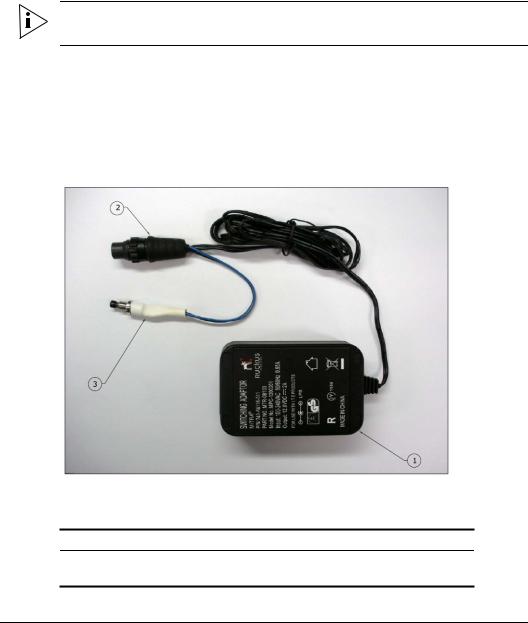
Preparing for Installation
Preconfiguring the Access Point (Standalone Only)
Step 2: Supply Power to the CMAP
In this step, you will connect the CMAP to the administrative computer, and then you will power it on using 12 VDC power.
NOTE: Before starting this procedure, you must have already obtained a DC power supply, such as 705-60224-002 shown in Figure 4.
To supply DC power to the CMAP
1.Connect one end of an Ethernet cable to the Ethernet port (labeled PoE OUT) on the CMAP, and then connect the other end to the administrative computer’s Ethernet port.
2.Remove the protective cap from the DC connector on the CMAP.
3.Connect the DC adapter (labeled 2 in Figure 4) to the DC connector on the CMAP.
Figure 4. DC switching adapter
Table 3 identifies the numbered components in Figure 4.
Table 3. DC switching adapter components
Number Description
1Power Supply: 100 to 240 VAC input. Connects with a standard IEC C13 style power cord.
8
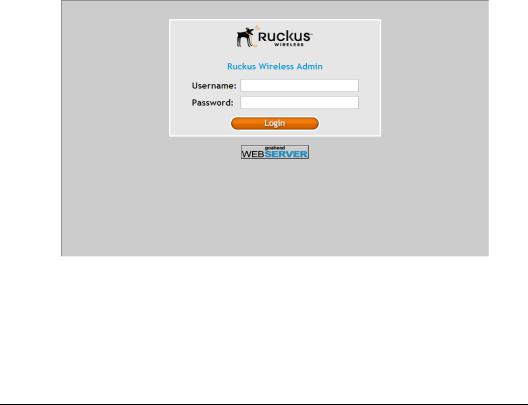
|
Preparing for Installation |
|
|
Preconfiguring the Access Point (Standalone Only) |
|
Table 3. |
DC switching adapter components |
|
|
|
|
Number |
Description |
|
|
|
|
2 |
Connector for the 12VDC connector on the CMAP |
|
|
|
|
3 |
Reset switch |
|
|
|
|
Step 3: Log Into the Access Point’s Web Interface
1.On the administrative computer, open a Web browser window.
2.In the address or location bar, type the following address: https://192.168.100.2
3.Press <Enter> on the keyboard to connect to the access point’s Web interface. A security alert message appears.
4.Click Yes or OK (depending on the browser) to continue. The access point’s login page appears.
Figure 5. The ZoneFlex Access Point login page
5.In User name, type super.
6.In Password, type sp-admin.
7.Click Log In. The Web interface appears, displaying the Device page.
8.Continue to “Step 4: Configure the Wireless Settings” below.
9

Preparing for Installation
Preconfiguring the Access Point (Standalone Only)
Step 4: Configure the Wireless Settings
To complete this step, you will need to configure the settings on the Common tab and at least one Wireless # tab. These are the essential wireless settings that will enable wireless devices on the network to associate with the access point.
NOTE: ZoneFlex 7762 has one 2.4GHz radio and one 5GHz radio. The wireless settings for each radio need to be configured separately on the Web interface (except for the country code setting, see note in Table 4). To configure the 2.4GHz radio settings, click Configuration > Radio 2.4G. To configure the 5GHz radio settings, click Configuration
> Radio 5G.
For your reference, the default wireless settings on the access point are listed in Table 4.
Table 4. Default wireless settings
Setting |
Default Value |
SSID (network name) |
Wireless 1 to Wireless 8 (8 WLANs) |
|
|
Encryption (security) |
Disabled on all WLANs |
|
|
Default management IP address |
192.168.100.2 |
|
|
Configure Common Wireless Settings
1.On the left menu of the Web interface, click Configuration > Radio {2.5/5} G. The Common page appears.
2.Verify that the common wireless settings are configured as listed in Table 8.
Table 5. Common wireless configuration
Setting |
Recommended Value |
Wireless Mode |
Auto-select |
|
|
Channel |
SmartSelect |
|
|
Channel Width |
20MHz or 40MHz |
|
|
10

|
Preparing for Installation |
|
Preconfiguring the Access Point (Standalone Only) |
Table 5. Common wireless configuration |
|
|
|
Setting |
Recommended Value |
|
|
Country Code |
• If you purchased the access point in the United States, |
this value is fixed to United States at the factory and is not user-configurable.
• If you purchased the access point outside of the United States, verify that the value is set to your country or region. Selecting the correct country code ensures that the access point uses only the radio channels allowed in your country or region.
NOTE: The two radios on ZoneFlex 7762 Access Point are always configured with the same country code setting. If you change the country code for Radio 2.4G, for example, the same change will be automatically applied to Radio 5G.
3.If you made any changes to the Common tab that you want to save, click Update Settings.
4.Continue to “Step 4: Configure the Wireless Settings” below.
Figure 6. The Configuration > Radio 2.4 > Common tab
Configure Wireless # Settings
1.Click one of the Wireless # tabs.
2.In Wireless Availability, click Enabled.
3.In Broadcast SSID, click Enabled.
11
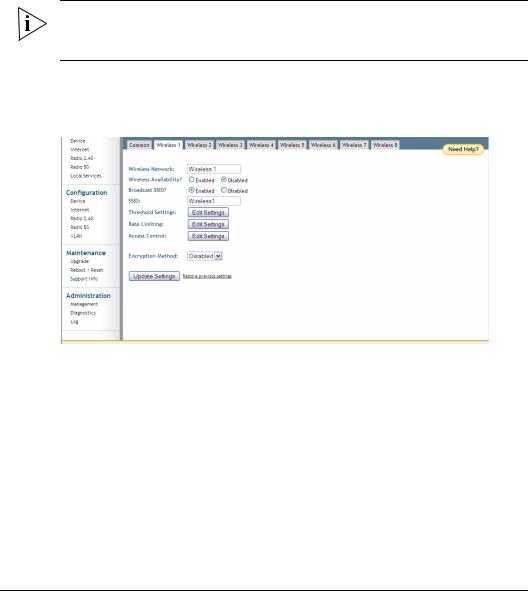
Preparing for Installation
Preconfiguring the Access Point (Standalone Only)
4.Clear the SSID box, and then type a unique and descriptive name that you want to call this wireless network.
For example, you can type Ruckus Wireless AP. This SSID is the name that will help users identify this wireless network in their wireless network connection application.
NOTE: You may also configure other wireless settings on this and other Wireless # tabs (in addition to the settings described above), although it is not necessary for completing the access point installation.
5. Click Update Settings.
You have completed configuring the basic wireless settings of the access point.
Figure 7. The Configuration > Radio 2.4 > Wireless 1 tab
12
